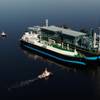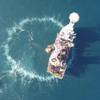Transformations: How a Coastal Ferry Became a Mercy Ship
By Captain Jon Fadely
The red sun drifted over the deep blue of the tropical Pacific on the western horizon, washing the surrounding Guatemalan countryside with a pale rose light. To the east, against a backdrop of hazy green volcanoes, we watched the cruise ship at the far end of the harbor preparing to depart. Her captain had made an unusual request, earlier that day: "When we sail this evening, could you sound your horn for us?" From the bridge wing of the Caribbean Mercy, we watched her stately transit of bright lights through the harbor. As the captain made his turn toward the open sea, passing astern of our berth, we sounded our air horn in a prolonged salute: safe voyage, happy return. When their ship arrived that morning, the captain and his wife had paid a social call. He said he recognized our Mercy Ship, the Caribbean Mercy, as a Norwegian coastal ferry. He had sailed on one similar in his youth. Yes, we confirmed, she was the former Polarlys, purchased by Mercy Ships in 1994 in Alesund, Norway, from TFDS. The captain then made his request, explaining that in earlier days in Norway, each coastal ferry had a distinctive horn, which it sounded upon arrival at a port of call. The residents could easily distinguish which ship was docking. He would appreciate hearing the old Polarlys call out, one more time. The transformation of a coastal Norwegian ferry into a hospital ship serving in Central America is a story spanning several years, and includes countless hours of volunteer skilled labor on the part of maritime professionals, medical experts, and craftsmen from many trades. Since 1978, Mercy Ships has pursued a vision of using ocean-going ships to provide free medical care and other relief services to the poor in developing countries, with volunteer crew members, funded by private donations. The first Mercy Ship, the Anastasis, began operation in 1981, in the South Pacific. Then the Mercy Ship moved to Central America and the Caribbean Sea in the mid-80's, and finally on to Africa throughout the 1990's, where she continues to work today. In 1983, a small Canadian ferry was donated to Mercy Ships. Re-named the Good Samaritan, this vessel joined the fleet and was put into active service until 2000. As Mercy Ships continued to grow, the opportunity to expand the fleet arose in 1994, when the Caribbean Mercy was purchased, and again in 1999, when the Africa Mercy was bought. The Caribbean Mercy measures 265 ft. LOA, 40 ft. beam, and draws 14 ft. 9 in. at her summer load line. Displacing 2,350 tons fully loaded, she can carry enough supplies and equipment in her two cargo holds and on deck, including eight vehicles and a trailer-mounted well-drilling machine, to support a three-month mission in a remote location. Originally fit with accommodations for 40 crew and 170 passengers, she now has berthing for 150, including four family suites. Designed for coastal cruising, her fuel and water tanks provide a cruising range of 12 days, or 3,600 miles. Because of the excellent maintenance performed by her previous Norwegian owners, the Caribbean Mercy was able to arrive on location for her first mission, in the Dominican Republic in June, 1994, only six weeks after her purchase. This was just enough time to accomplish the necessary legal formalities, sail across the Atlantic to Florida, and load on the mission supplies and equipment. In those first years of operation as a Mercy Ship, her medical capabilities were limited to field clinics. Portable equipment and supplies were carried onboard, along with the trucks and vans to transport material and medical teams inland to local villages. The vision was to transform her into a floating hospital ship, where the blind could receive their sight through quick, low-risk surgical procedures. In consultations at Mercy Ships offices and onboard the vessel, a team of medical experts, eye surgeons, and hospital designers planned the new facility to be state-of-the-art. Plan approval from the vessel's classification society, Det Norske Veritas, ensured compliance with international safety regulations. Campaigns to raise the necessary finances and recruit skilled workers began. Rather than lay the vessel up for an extended period of renovations, the decision was made to keep her in active service in relief missions and good-will tours, while scheduling phases of the conversion work over several years. By the close of 1994, preparatory work began onboard, with the removal of the aft lower deck cabins, formerly third class passenger berths. Gutted back to the frames and beams, the space opened up was roughly 40 ft. long, by thirty-eight feet at its wider, forward end, and twenty-eight feet wide at its narrower aft end. With cambered decks and flared hull sides, it was difficult to find a square angle in the entire compartment. One of the hospital designers on the planning team admitted he had never drafted a hospital plan quite like this before. He decided to build a scale, three-dimensional model of the surgery, to be sure the equipment would fit. With final plan approval in hand, and materials purchased with the funds raised, construction of the medical facility began in the summer of 1995. It proceeded slowly over the next 18 months, as the Mercy Ship continued a full schedule of relief missions in the Caribbean and Central America, and good-will tours in the USA and Canada. System by system, layer by layer, the new clinic took shape. First, the basic structure was addressed: repairs to the steel deck, corroded thin in some areas; fitting a new watertight door to provide a secondary emergency escape; enclosing the main staircase in steel for fire protection. Next, service systems were installed: plumbing, ventilation, lighting and wiring, and alarm circuits. Then, as the interior bulkheads were set in place, some form emerged out of the void; a sizable operating theater in the forward, wider portion, with several small offices and lockers fit into the more narrow section aft. In order to support modern medical work in the tropics, air conditioning is essential, not only for cooling, but also for filtering the air. In the summer of 1995, while the Mercy Ship was on a good-will tour of the Great Lakes, the air-conditioning project began. The boiler, formerly used in Norway to make steam for heating, was cut up and removed. In its place, over the next year, two custom-built chill-water air conditioning units were assembled. New air handlers in all the vent stations were designed and built by volunteer HVAC crew. Early in the summer of 1996, while on the U.S. Gulf Coast, the system was powered up for the first time, and the ship's interior was soon cool and comfortable. By the fall of 1996, while the Mercy Ship conducted a relief mission to Guatemala, basic construction of the surgical clinic was completed. Cabinets, flooring, and trim were planned to be finished over the coming winter, and the delivery of the donated medical equipment was scheduled. The cabinetry proved to be very challenging, with every desk and counter top a custom-fit job in spaces with few square angles. In December 1996, the two free-standing ophthalmic microscopes were received onboard, assembled in the operating room, and adjusted by the manufacturer's technicians. Two patient's beds, attendant's chairs, equipment carts, autoclaves, monitors and instruments completed the surgical ensemble. A simple dedication ceremony officially inaugurated the surgical clinic in January 1997. The ship returned to Guatemala to undertake its first surgical mission; the first patient to receive her sight was aptly named Esperanza - "hope". During these first surgical procedures, a significant problem became apparent. The ship's three original generator auxiliaries, medium-speed diesels from 1948, induced significant vibration in the ship's hull, which traveled to the surgery deck, and into the microscopes, causing them to shake. The medical teams managed to work with this inconvenience, but each eye operation took more time than planned, and the surgeons were over-tired by the end of their day. Compounding these issues, a string of problems with these engines' main bearings indicated that expensive major overhauls would be needed soon. Upgrading the electrical plant with new, more efficient generators became a top priority. The ship needed a new "heart." For the next mission of the Mercy Ship to the Pacific coast of Guatemala, shore power was arranged to avoid running the generators. It was during this visit to Puerto Quetzal that we met the Norwegian captain with fond memories of the sound of the ship's horn. Meanwhile, another team of specialists was recruited from the growing pool of Mercy Ships short-term volunteer craftsmen. The Marine Operations department at the Mercy Ships headquarters in Texas took the lead in planning the engineering details of the project, again working with the classification society to ensure compliance in all critical areas. In the spring of 1998, the Mercy Ship put in to San Diego, ready for her "transplant operation". Once the "patient" was connected to shore power, the old generators were shut down for the last time. Access was cleared through the skylight, down five decks, inside the "ribs," to the machinery "chest". The three old units were cut apart and removed, and two new replacements were shoe-horned into position. Essential plumbing for vital fluids was connected; new "arteries" of wiring were fitted, along with distribution panels and rectifiers. The auxiliary engines were test-run - we have a pulse! - and soon the "juice" was flowing. Final surveys were completed in April, and the Mercy Ship, stronger than before, tooled up for her next medical mission. With any ship in active service, there's always something to repair or improve, and the vessels in the growing fleet of Mercy Ships is no exception. The care and efforts of many volunteers over the years -- welders, electricians, plumbers, carpenters, and others -- with their gift of countless hours of skilled labor, have transformed these graceful old ladies of the sea into ambassadors of hope and healing for the world's poor. Each volunteer has received in return the deep satisfaction of knowing their work will help improve and even save the lives of others for years to come. For more information on Mercy Ships in general or the Caribbean Mercy specifically, visit www.mercyships.org, or contact: Mercy Ships, P.O. Box 2020, Garden Valley, TX 75771, USA, Attn: Marine Operations; Phone: (903) 939-7000.










